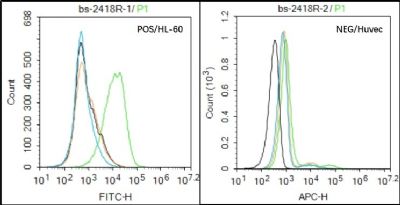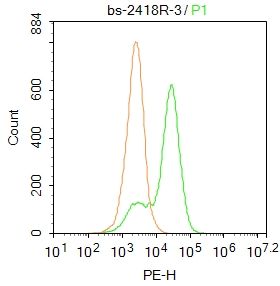NCR3 is a cytotoxicity-activating receptor that may contribute to the increased efficiency of activated natural killer (NK) cells to mediate tumor cell lysis. It is a member of the Ig superfamily and may cooperate with NKp46 and NKp44 in the induction of cytotoxicity against a variety of target cells and is selectively expressed by all NK cells, both freshly isolated and cultured in IL2, thus representing an optimal marker for NK cell identification. Similar to NKp46 and CD16, NKp30 associated with CD3 zeta chains becomes tyrosine phosphorylated following cell treatment with pervanadate. Its extracelluar portion is characterized by a single domain of the SLVtype and by a region rich in hydrophobic amino acids, potentially involved in protein/protein interactions that connects the Ig SLVlike domain with the transmembrane portion. It is selectively expressed by all resting and activated NK cells and weakly expressed in spleen.
Function:
Cytotoxicity-activating receptor that contributes to the increased efficiency of activated natural killer (NK) cells to mediate tumor cell lysis. Engagement of NCR3 by BAG6 also promotes dendritic cell (DC) maturation, both through killing those DCs that did not properly acquire a mature phenotype, and inducing NK cells to release TNFA and IFNG, which promotes DC maturation.
Subunit:
Homodimer in the unliganted form. Interacts with CD3Z. Interacts with and is activated by binding to B7H6. Interacts with and is activated by binding to BAG6.
Subcellular Location:
Cell membrane; Single-pass type I membrane protein.
Tissue Specificity:
Selectively expressed by all resting and activated NK cells and weakly expressed in spleen.
Similarity:
Belongs to the natural cytotoxicity receptor (NCR) family.
Contains 1 Ig-like (immunoglobulin-like) domain.
SWISS:
O14931
Gene ID:
259197
Database links:
Entrez Gene: 259197 Human
Entrez Gene: 294251 Rat
Omim: 611550 Human
SwissProt: O14931 Human
SwissProt: Q8CFD9 Rat
Unigene: 509513 Human
Unigene: 20646 Rat
细胞毒性受体家族(NCRs)主要有:NKp46、NKp44和NKp30,其中NKp46和NKp30表达于所有静止和活化的NK细胞,而NKp44则选择性的表达于活化的NK细胞。靶细胞上的配体分子与NCRs的结合(交联)引发NK细胞的活化导致靶细胞的裂解和大量细胞因子的产生。现已确认NKp46和NKp44可以识别病毒上的配体分子红血球凝聚素,而NKp46则能识别肿瘤细胞上的乙酰硫酸多聚糖。
| Picture |
Black line : Positive blank control (HL60); Negative blank control (HUVEC)
Green line : Primary Antibody (Rabbit Anti-NCR3 antibody (SL2418R) )
Orange line:Isotype Control Antibody (Rabbit IgG) .
Blue line : Secondary Antibody (Goat anti-rabbit IgG-AF647)
HL60(Positive)and HUVEC(Negative control)cells (black) were incubated in 5% BSA blocking buffer for 30 min at room temperature. Cells were then stained with NCR3 Antibody(SL2418R)at 1:50 dilution in blocking buffer and incubated for 30 min at room temperature, washed twice with 2% BSA in PBS, followed by secondary antibody(blue) incubation for 40 min at room temperature. Acquisitions of 20,000 events were performed. Cells stained with primary antibody (green), and isotype control (orange).
Blank control: HL60.
Primary Antibody (green line): Rabbit Anti-NCR3 antibody (SL2418R)
Dilution: 3μg /10^6 cells;
Isotype Control Antibody (orange line): Rabbit IgG .
Secondary Antibody : Goat anti-rabbit IgG-PE
Dilution: 1μg /test.
Protocol
The cells were incubated in 5%BSA to block non-specific protein-protein interactions for 30 min at at room temperature .Cells stained with Primary Antibody for 30 min at room temperature. The secondary antibody used for 40 min at room temperature. Acquisition of 20,000 events was performed.
|
|
|

